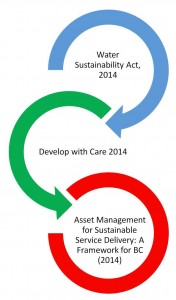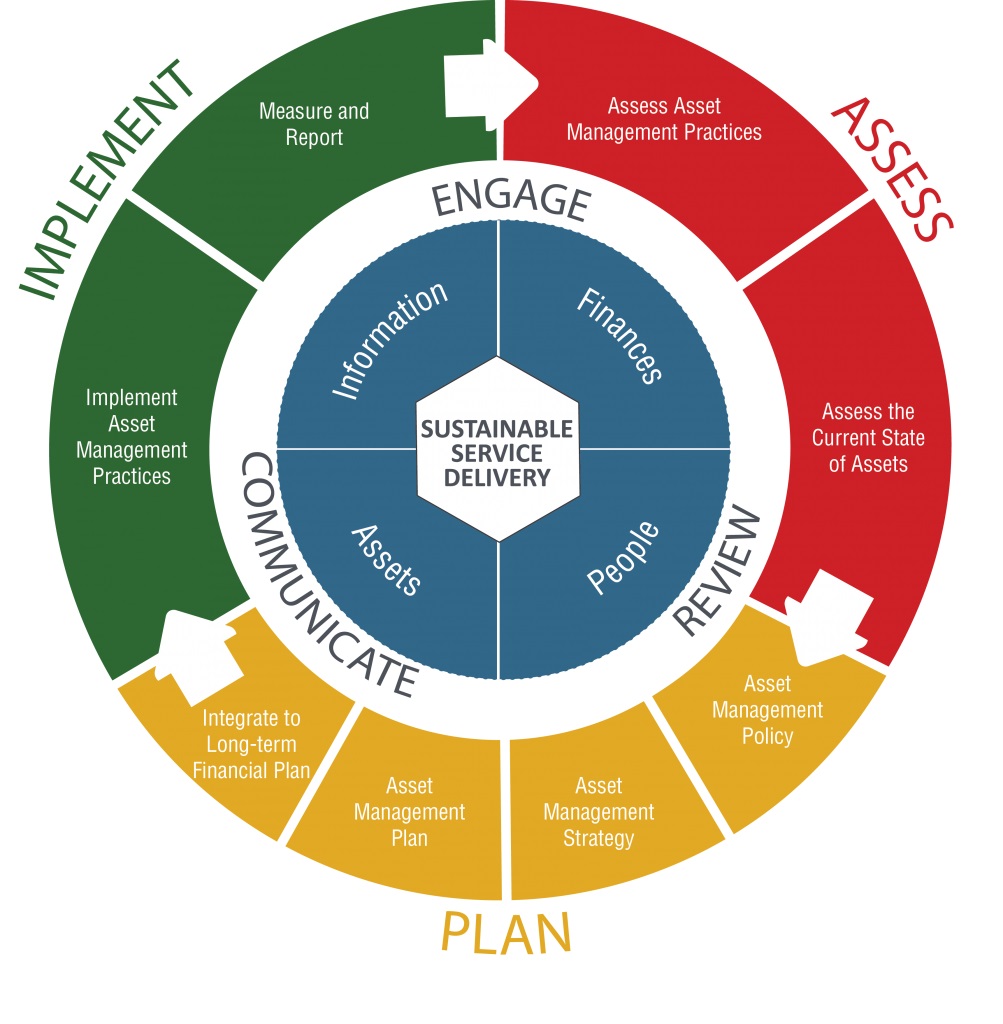Towards Watershed Sustainability: "Asset Management for Sustainable Service Delivery" is aligned with BC's capital grants program (Provincial Driver #3 in 2014)
Note to Reader:
 The Province of British Columbia has long recognized that communities are in the best position to develop solutions which meet their own unique needs and local conditions. Furthermore, the emphasis in BC is on progressing towards a desired outcome.
The Province of British Columbia has long recognized that communities are in the best position to develop solutions which meet their own unique needs and local conditions. Furthermore, the emphasis in BC is on progressing towards a desired outcome.
Three landmark initiatives came to fruition in 2014. All embody the enabling philosophy. Together they provide a platform for integrated and coordinated actions that would enable local governments to achieve Sustainable Watershed Systems, through Asset Management.
Accepted ‘standards of practice’- especially those for engineering, planning and finance – influence the form and function of the Built Environment. Creating a watershed health legacy will ultimately depend on implementing ‘Design with Nature’ standards of practice.
To download a PDF copy of the article posted below, click on Asset Management for Sustainable Service Delivery: an overview. This is an extract from Part B of ‘Beyond the Guidebook 2015: Sustainable Watershed Systems, through Asset Management’.

Branding graphic for “Asset Management for Sustainable Service Delivery: A Framework for BC”. To download a copy, click on https://waterbucket.ca/wscblog/files/2015/01/Asset-Management-for-Sustainable-Service_Delivery_A-Framework_for_BC_Dec-2014_short-version.pdf
Asset Management Defined
Asset Management is an integrated process, bringing together skills, expertise, and activities of People; with Information about a community’s physical Assets; and Finances; so that informed decisions can be made, supporting Sustainable Service Delivery.
Asset Management for Sustainable Service Delivery: A Framework for BC is a landmark initiative. Several years in the making, the BC Framework is aligned with the asset management requirements for the Province’s capital grants programs, and is therefore a game-changer.
Sustainable Service Delivery encompasses water resources and drainage, and hence, will determine the achievability of the Watershed Health Goal.
The Province’s grants program provides a financial incentive for local governments to demonstrate how they can fulfil ‘Design with Nature’ objectives and expectations that are both explicit and implicit in the BC Framework.
Land Servicing and the ‘Unfunded Infrastructure Liability’
The unwanted legacy of historical ‘stormwater management’ is the unfunded liability that is created when land development and infrastructure servicing practices combine to harden the landscape and short-circuit the natural Water Balance (image below).
When altering of the land surface short-circuits the Water Balance, consequences include expensive drainage and stream stabilization fixes (in an era when communities are challenged to fund and replace essential infrastructure services).
Implementing ‘Design with Nature’ development practices at the site scale – so that benefits accumulate and mimic the natural Water Balance at a watershed scale – ultimately means that communities will be more resilient during periods when there is either too much or too little rain.
Focus on Desired Outcomes
Over the past 15 years in BC, local government leaders have been applying science-based understanding to develop tools, establish precedents and gain the experience necessary to implement practices that would ultimately achieve the Watershed Health Goal.
The “missing link” in the sharing and learning process has been an opportunity or driver to package the tools, precedents and experience into a comprehensive and integrated application.
The renewed Gas Tax Agreement complete with requirements to implement the BC Framework (in order to meet asset management commitments) now provides a timely driver for such integration.
Outcome-oriented, the BC Framework is the catalyst for local governments to integrate natural systems and climate change thinking into Asset Management, and forestall an ‘unfunded infrastructure liability’.
Asset Management Continuum:
“The BC Framework provides a high level overview of what is needed to develop, implement and maintain strong asset management practices for local governments. The BC Framework also points the way to  integration of natural systems and climate change thinking into asset management,” explains Liam Edwards, Executive Director (for Infrastructure and Finance, Local Government Division) in the Ministry of Community, Sport and Cultural Development.
integration of natural systems and climate change thinking into asset management,” explains Liam Edwards, Executive Director (for Infrastructure and Finance, Local Government Division) in the Ministry of Community, Sport and Cultural Development.
“Resilient cities will be the ones that can absorb water and manage the water cycle as a closed loop. We can view asset management as a continuum. Communities will progress along it incrementally as their understanding grows. By accounting for and integrating the services that nature provides, they can achieve the goal of Sustainable Service Delivery for watershed systems.”


